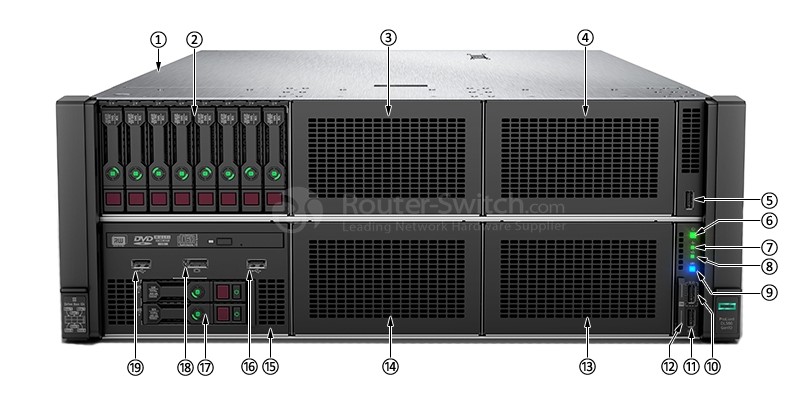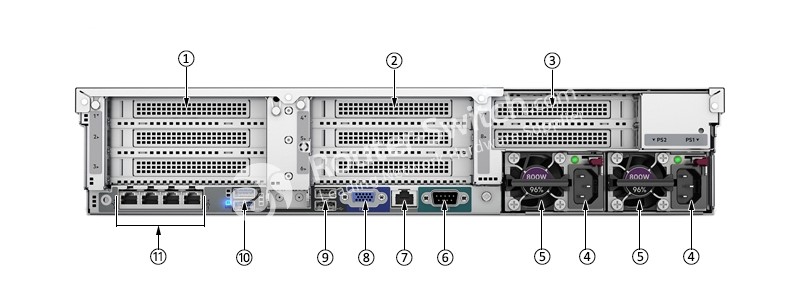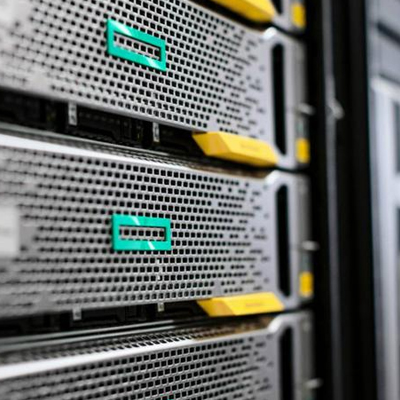HPE provides us various series of servers to meet our different needs, such as DL380, DL360, DL380 plus, DL360 plus and so on. Today, we are going to introduce HPE 4 sockets servers, the ProLiant DL580 and DL560.
This figure shows the HPE 4 socket server family:

We have introduced the benefits of HPE Proliant at the post 5 Reasons of Choosing HPE ProLiant Gen 10 Plus Servers. Here, we still want to tell you how powerful the HPE ProLiant is.
HPE ProLiant provides these benefits:
- Optimization
– Workload Matching
– Workload Performance Advisor
- Secure
– HPE Silicon Root of Trust
– HPE Secure Compute Lifecycle
– HPE Support of Commercial National Security Algorithm
– HPE Automated Recovery
- Automation
– HPE InfoSight for Servers
– Increased manageability delivered through HPE Integrated Lights-Out 5
– All-in-one converged management option with HPE OneView
Now, let’s expand those features of DL580 and DL560.
HPE ProLiant DL580 Gen10 server
The 4P 4U HPE ProLiant DL580 Gen10 server has the characteristics of security and high scalability, which can guarantee the computing performance of key business. Its scalable computing performance can meet the needs of large-scale critical workloads and provide higher storage capacity and IO performance than the previous generation products. Its flexible and safe design is suitable for running mission-critical workloads.
Figure 2 shows the front panel of DL580 Gen 10.

Note:
| ① | Quick removal access panel |
| ② | Box 1 (8 SFF, 6 SFF+2 NVMe or 8 NVMe (supports only 4 NVMe drives) SSD optional) |
| ③ | Box 2 (8 SFF, 6 SFF+2 NVMe or 8 NVMe PCIe SSD optional) |
| ④ | Box 3 (8 SFF, 6 SFF+2 NVMe or 8 NVMe PCIe SSD optional) |
| ⑤ | Front USB 3.0 port |
| ⑥ | Power On/Standby button and system power LED button |
| ⑦ | Health LED |
| ⑧ | NIC status |
| ⑨ | UID button |
| ⑩ | iLO Front Service Port |
| ⑪ | Front USB 3.0 port |
| ⑫ | Serial label pull tag |
| ⑬ | Box 6 (8 SFF) |
| ⑭ | Box 5 (8 SFF) |
| ⑮ | Box 4 (8 SFF or Universal Media bay) |
| ⑯ | Optional USB 2.0 (via Universal Media Bay) |
| ⑰ | Optional 2 SFF HDD, requires optional Universal Media bay |
| ⑱ | Optional front display port (via Universal Media Bay) |
| ⑲ | Optional USB 2.0 (via Universal Media Bay) |
Figure 3 shows the back panel of DL580 Gen 10.

Note:
| ① | PCIe Slots (Slots 1-7 top to bottom), requires primary riser |
| ② | PCIe Slots (Slots 8-14 top to bottom), requires secondary riser (includes tertiary riser) |
| ③ | PCIe Slots (Slots 15-16 top to bottom), requires tertiary riser (included with secondary riser) |
| ④ | Power supply Power LED (max. 4) |
| ⑤ | Power supply Power connection (max. 4) |
| ⑥ | HPE Flexible Slot Power Supply, 800W PS shown (max. 4) |
| ⑦ | Serial connector |
| ⑧ | Dedicated iLO connector |
| ⑨ | VGA (video) connector |
| ⑩ | USB connectors 2.0 (2) |
| ⑪ | USB connectors 3.0 (2) |
| ⑫ | Unit ID LED |
| ⑬ | FlexibleLOM ports (Port 1 on right side) |
Table 1 shows the main spec of DL580.
| Series | HPE ProLiant DL580 Gen10 Server |
| Processor | Up to 4 Intel Xeon scalable processors, and a single processor can have up to 28 cores. |
| Memory | 48 DDR4 memory, up to 2933 MT/s (maximum 6 TB) Permanent memory, support up to (24) NVDIMM/DCPMM |
| Hard Disk | Up to (48) SFF HDD/SSD hard disks |
| Slot | Optional HPE Universal Media Slot (Optical Drive/Front VGA) |
| Kit | M.2 support kit and 20 NVMe SSD option SD card kit |
| Software | Standard HPE Smart Array S100i Software RAID Optional HPE Smart Array basic model and Performance RAID Controllers to cooperate to achieve additional features. |
| Network Card | Pluggable LOM network card or vertical network card, optional types include 1GbE, lOGbE and 25GbE. |
| PCIE | 16 PCI-E3.0 slots (4 FL/FH) |
| Power Supply | 4 FlexSIot 800 W or 1600 W power supplies |
| Other | HPE security encryption, TPM option digital firmware identification and rack intrusion detection |
HPE ProLiant DL560 Gen10 server
The secure and high-density 4P 2U HPE ProLiant DL560 Gen10 server provides mission-critical computing performance. Intensive, scalable servers can be used for workloads that need to be expanded. Considerable density, more storage in a 2 U compact chassis, flexible IO, safe design, and ability to run critical business workloads.
Figure 4 shows the front panel of DL560 Gen 10.

Note:
| ① | Optional Optical drive. Requires Universal Media bay |
| ② | Quick removal access panel |
| ③ | Optional front Display Port (via Universal Media Bay) |
| ④ | iLO Front Service Port |
| ⑤ | USB 3.0 |
| ⑥ | Serial label pull tag |
| ⑦ | Drive Box 3. (8 SFF, 6SFF+2NVMe optional) |
| ⑧ | Optional USB 2.0 (via Universal Media Bay) |
| ⑨ | Drive Box 1. (Optional Universal Media bay,8 SFF bay or 6 SFF+2NVMe optional) |
| ⑩ | Optional 2 SFF HDD, requires optional Universal Media bay |
| ⑪ | Optional USB 2.0 (via Universal Media Bay) |
Figure 5 shows the back panel of DL560 Gen 10.

Note:
| ① | PCIe Slots (Slots 1-3 top to bottom, riser shipped standard) |
| ② | PCIe Slots (Slots 4-6 top to bottom, requires second riser card and second processor) |
| ③ | PCIe Slots (Slots 7-8 top to bottom), requires tertiary riser card and second processor, Not available with 4x Flex Slot power supplies |
| ④ | Power supply power connections |
| ⑤ | HPE Flexible Slot Power Supply bay 1 and 2 (800W PS shown) |
| ⑥ | Serial connector |
| ⑦ | Dedicated iLO connector |
| ⑧ | VGA (video) connector |
| ⑨ | USB connectors 2.0 (2) |
| ⑩ | USB connectors 3.0 (2) |
| ⑪ | FlexibleLOM ports (Port 1 on right side) |
Table 2 shows the main spec of DL560.
| Series | HPE ProLiant DL560 Gen10 Server |
| Processor | Up to 4 Intel Xeon processor scalable family series, up to 28 cores |
| Memory | 48 DDR4, up to 2933 MT/S (6 TB max) Permanent memory up to (24) NVDIMM/DCPMM |
| Hard Disk | Up to (24) SFF (maximum), HDD/SSD |
| Kit | M2 configuration kit and 12 NVMe SSD products Dual SD card boot kit |
| RAID | Support RAID 0/1/10/5/50/6/60 and 1/10 ADM |
| PCIE | 8 PCIe 3.0 slots |
| Power Supply | Support 4 hot-swappable redundant power supplies |
If you want to order DL580 or DL560 servers, welcome to visit:
HPE ProLiant DL580 Gen10 Servers
HPE ProLiant DL560 Gen10 Servers
Related Topics:
5 Reasons of Choosing HPE ProLiant Gen 10 Plus Servers
HPE DL380 Gen10 Plus Server vs. DL380 Gen10 Server
Dell PowerEdge 14G Servers vs. HPE ProLiant Gen 10 Servers

